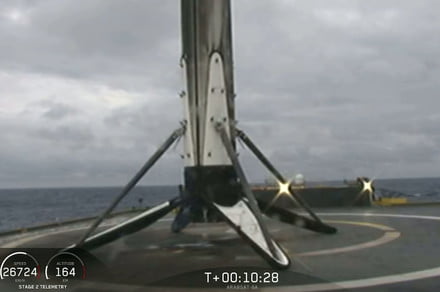SpaceX
SpaceX has lost the center core booster of its Falcon Heavy rocket after it fell into the ocean in stormy conditions.
The booster of the world’s most powerful operational rocket made a successful landing on the SpaceX drone ship in the Atlantic Ocean on April 11 following its second-ever launch and its first commercial mission.
“Over the weekend, due to rough sea conditions, SpaceX’s recovery team was unable to secure the center core booster for its return trip to Port Canaveral,” SpaceX said in a statement on Monday. “As conditions worsened with 8- to 10-foot swells, the booster began to shift and ultimately was unable to remain upright. While we had hoped to bring the booster back intact, the safety of our team always takes precedence. We do not expect future missions to be impacted.”
Aside from the loss, the mission itself was deemed a success. It also marked the first time for SpaceX to land three boosters at once, with two returning safely to dry land and the now-lost booster performing a perfect touchdown on the drone ship.
SpaceX has made more than 20 drone-ship landings with its smaller Falcon 9 rocket over the last four years. While the team is working constantly to improve the reusable rocket’s landing technology, several of the early missions saw it topple over and explode seconds after touchdown. The landing system has now been significantly improved, though it does still suffer the occasional hiccup, including during the Falcon Heavy’s maiden flight when the center core malfunctioned on the way down and missed the drone ship altogether.
It’s the first time for SpaceX to lose a booster in rough weather following a safe landing. The drone ship has a way to secure the Falcon 9 booster after landing, but the slightly different design of the Heavy’s booster prevents the same system from being used. The company is planning to adapt the system in time for the Heavy’s next launch in the summer.
Falcon Heavy
The Falcon Heavy is perhaps most simply described as three Falcon 9 rockets strapped together, a design that enables it to pack more than 5 million pounds of thrust — equivalent to eighteen 747 aircraft all firing at once. It’s the biggest rocket in operation today, and the second biggest to date after the Saturn V, the rocket that thrust multiple moon missions into space in the late 1960s and early 1970s.
The Falcon Heavy’s first outing in 2018 was primarily for test purposes and included sending a Tesla Roadster owned by SpaceX CEO Elon Musk on a journey toward Mars and beyond. Compared to the Falcon 9, the Falcon Heavy paves the way for heavier payloads and more ambitious missions using SpaceX’s reusable rocket system.
Last week’s mission was the Falcon Heavy’s first commercial launch, deploying into orbit the Lockheed Martin-built Arabsat-6A communications satellite for the provision of TV, internet, and phone services in the Middle East, Africa, and Europe.
Editors’ Recommendations
- Germany’s space agency wants to catch rockets in the sky after launch
- Watch this SpaceX ship come tantalizingly close to catching rocket parts
- Israel will launch world’s first privately funded moon mission tomorrow
- SpaceX just nailed its most challenging Falcon 9 rocket landing to date
- Prepare for liftoff: Here are all the important upcoming SpaceX rocket launches

